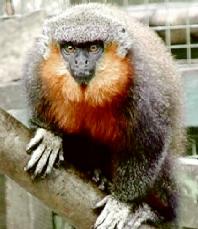
Two New Monkeys Found in Amazon Rainforest
by Cat Lazaroff
 |
by Cat Lazaroff |
|
 (ENS) WASHINGTON --
Two
never before described species of monkey have been found in Brazil's Amazon rainforest. The scientists responsible for the discovery say there are likely to be other species within the rainforest that are unknown to science, and their existence lends even greater urgency to the race to save one of the most biologically diverse ecosystems on Earth.
(ENS) WASHINGTON --
Two
never before described species of monkey have been found in Brazil's Amazon rainforest. The scientists responsible for the discovery say there are likely to be other species within the rainforest that are unknown to science, and their existence lends even greater urgency to the race to save one of the most biologically diverse ecosystems on Earth.
Conservation International announced June 24 the discovery of two new species of titi monkey in Brazil's Amazon rain forest. The monkeys were described by Marc van Roosmalen, a primatologist at Brazil's National Institute for Amazon Research (INPA), his son, Tomas van Roosmalen, and Russell Mittermeier, president of Conservation International and chair of the World Conservation Union Species Survival Commission's (IUCN/SSC) primate specialist group. "Even though our closest living relatives, the primates, have been very well studied for the past four decades, we are once again surprised by the discovery of even more species," said Mittermeier. "It proves how much we still need to learn about biological diversity, especially in the tropical rainforests." One of the species, Callicebus bernhardi, or Prince Bernhard's titi monkey, is remarkable for its dark orange sideburns, chest and the inner sides of its limbs, its reddish brown back, and a white tipped black tail. It lives between the east bank of the Rio Madeira and the lower reaches of its tributary, the Rio Aripuana, south of the Amazon River. Callicebus bernhardi is named for His Royal Highness Prince Bernhard of the Netherlands, a noted naturalist who created the Order of the Golden Ark to honor conservationists around the world. Both Marc Van Roosmalen and Russell Mittermeier are past recipients of the award. Van Roosmalen will present the discovery to the Prince in a special ceremony at Soestdijk Palace in Holland on June 25, four days before the Prince's 91st birthday. Prince Bernhard will also receive a special portrait of his monkey by Stephen Nash, Conservation International's technical illustrator, who has made major contributions to primate conservation worldwide through his posters and educational materials. The second new species, Callicebus stephennashi, is named after Nash, who works for Conservation International and is based at the Department of Anatomical Sciences at the State University of New York at Stony Brook. Stephen Nash's titi monkey was brought to scientists by local fishers. Callicebus stephennashi, or Stephen Nash's titi monkey, is silver in color, with a black forehead and red sideburns, chest and inner sides of limbs. Since native fishers brought the animal to Van Roosmalen's breeding center for endangered wildlife in Manaus, the researchers are not sure where its native habitat lies, though Van Roosmalen believes it came from the eastern bank of the Rio Purus in Central Amazonia. "I am currently using my new discoveries to convince the Brazilian government to create nature reserves in the areas where I have found these species and where others, yet unknown to science, are likely to live," said Marc van Roosmalen. "The Amazon is extremely rich in biodiversity, and these newly discovered creatures should be regarded as flagship species." Scientists have described 24 monkeys new to science since 1990, according to Anthony Rylands, senior director at the Center for Applied Biodiversity Science at Conservation International. Thirteen of these new species are from Brazil. Including these two monkeys, Brazil now has 95 species of primates, far more than any other country, and 134 species and subspecies, close to one-quarter of the global total. Titi monkeys are about the size of a small cat. They live in the dense understory of the South American tropical forests in small family groups of a mated pair and their offspring. Twenty-eight species, each with unique and colorful fur patterns, are now known to occur in the Amazon basin and the Atlantic forest of eastern Brazil. Primates, including these new species, face many threats, including habitat destruction, bushmeat hunting, and live capture for the pet trade. The most recent assessment of primate conservation status carried out by the IUCN/SSC indicates that 150 species, or one in four, are in the endangered and critically endangered categories of IUCN and that 55, or one in 10, are critically endangered. At the most recent congress of the International Primatological Society, held in Adelaide, Australia in January 2001, the Society outlined an action plan aimed at maintaining the full range of primate diversity. The plan recommends focusing conservation efforts on the 150 most critically endangered and endangered species by determining the areas that need protection, identifying the projects that need to be instituted, and establishing cost. Brazil, with its concentration of primates and the ongoing threat of deforestation, has received special attention. In September 2001, Conservation International aided in the creation of a new private reserve in Caratinga, Brazil, to help protect the critically endangered northern muriqui monkey. And in April 2001, the government of Brazil created a new protected area to aid in the recovery of the golden lion tamarin - a tiny monkey that numbers about 1,000 in the wild. An account of the newly discovered titi monkeys appears in a just released special supplement to the journal "Neotropical Primates."
Albion Monitor
July 6 2002 (http://albionmonitor.net) All Rights Reserved. Contact rights@monitor.net for permission to use in any format. |